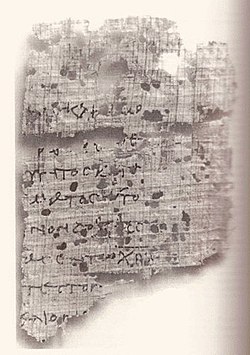Papyrus 92
aus Wikipedia, der freien Enzyklopädie
| Papyrus 92 | |
|---|---|

| |
| Name | P. Narmuthis 69.39a/229a |
| Text | Epheserbrief 1; 2. Thessalonicherbrief 1 |
| Sprache | griechisch |
| Datum | 3. Jahrhundert |
| Gefunden | Ägypten |
| Lagerort | Ägyptisches Museum in Kairo |
| Quelle | C. Galazzi, Frammenti di un codice con le Epistole de Paolo, ZPE 46 (1982), S. 117–122 |
| Größe | 14,5 × 21,5 cm |
| Typ | Alexandrinischer Texttyp |
| Kategorie | keine |
Papyrus 92 (nach Gregory-Aland mit Sigel 92 bezeichnet) ist eine frühe griechische Abschrift des Neuen Testaments. Mittels Paläographie wurde sie auf das 3. Jahrhundert datiert.[1][2]
Beschreibung
[Bearbeiten | Quelltext bearbeiten]Die Handschrift stammt aus dem ägyptischen Narmouthis, heute trägt der Ort den Namen Medinet Madi. Das Papyrusfragment des Epheserbriefs enthält nur die Verse 1,11-13.19-21. Ein weiterer Teil enthält die Verse 1,4-5.11-12. des 2. Thessalonicherbriefs. Es ist das früheste Fragment des 2 Thessalonicherbriefs.[3]
Text
[Bearbeiten | Quelltext bearbeiten]Der griechische Text des Kodex repräsentiert den alexandrinischen Texttyp. Das ist textlich 46, Codex Sinaiticus, und Vaticanus nah.[4]
Aufbewahrungsort
[Bearbeiten | Quelltext bearbeiten]Die Handschrift wird zurzeit im Ägyptischen Museum unter der Signatur P. Narmuthis 69.39a/229a in Kairo aufbewahrt.[1][2]
Einzelnachweise
[Bearbeiten | Quelltext bearbeiten]- ↑ a b INTF, Handschriftliste
- ↑ a b Kurt und Barbara Aland: Der Text des Neuen Testaments. Einführung in die wissenschaftlichen Ausgaben sowie in Theorie und Praxis der modernen Textkritik. Deutsche Bibelgesellschaft, Stuttgart 1989, S. 321, ISBN 3-438-06011-6
- ↑ Philip W. Comfort, Encountering the Manuscripts. An Introduction to New Testament Paleography & Textual Criticism, Nashville, Tennessee: Broadman & Holman Publishers, 2005, S. 74.
- ↑ Philip W. Comfort, The Text of the Earliest New Testament Greek Manuscripts, 2001, S. 625.
Siehe auch
[Bearbeiten | Quelltext bearbeiten]Literatur
[Bearbeiten | Quelltext bearbeiten]- Claudio Galazzi, Frammenti di un codice con le Epistole de Paolo, Zeitschrift für Papyrologie und Epigraphik 46 (Bonn: 1982), S. 117–122.
Abbildungen
[Bearbeiten | Quelltext bearbeiten]Text is available under the CC BY-SA 4.0 license; additional terms may apply.
Images, videos and audio are available under their respective licenses.

